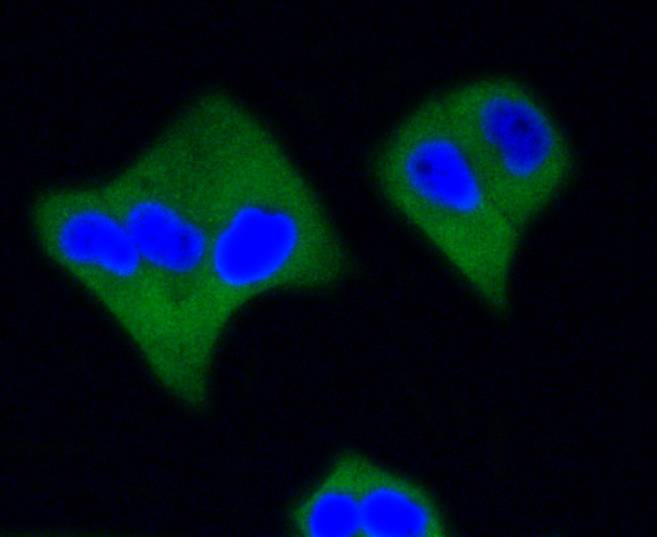Active Caspase-3 Recombinant Rabbit Monoclonal Antibody [SR01-02], Unconjugated
- Images (5)
| Article Name: | Active Caspase-3 Recombinant Rabbit Monoclonal Antibody [SR01-02], Unconjugated |
| Biozol Catalog Number: | HBO-ET1602-47 |
| Supplier Catalog Number: | ET1602-47 |
| Alternative Catalog Number: | HBO-ET1602-47 |
| Manufacturer: | HUABIO |
| Host: | Rabbit |
| Category: | Antikörper |
| Application: | IF, IHC-P, WB |
| Species Reactivity: | Human, Porcine |
| Immunogen: | Synthetic peptide within Human Caspase-3 aa 28-67 / 277. |
| Conjugation: | Unconjugated |
| Alternative Names: | Caspase3 A830040C14Rik antibody Apopain antibody CASP 3 antibody CASP-3 antibody CASP3 antibody CASP3_HUMAN antibody Casp3a antibody Caspase 3 antibody Caspase 3, apoptosis-related cysteine peptidase antibody Caspase 3, apoptosis-related cysteine proteas |
| Caspase-3 is a caspase protein that interacts with caspase-8 and caspase-9. It is encoded by the CASP3 gene. CASP3 orthologs have been identified in numerous mammals for which complete genome data are available. Unique orthologs are also present in birds |
TARGETUNIPROT #P42574 PROTEIN NAME Active Caspase-3 SYNONYMS A830040C14Rik antibody; Apopain antibody; CASP 3 antibody; CASP-3 antibody; CASP3 antibody; CASP3_HUMAN antibody; Casp3a antibody; Caspase 3 antibody; Caspase 3, apoptosis-related cysteine peptidase antibody; Caspase 3, apoptosis-related cysteine protease antibody; Caspase 3, apoptosis-related cysteine protease a antibody; Caspase-3 subunit p12 antibody; Caspase3 antibody; CC3 antibody; CPP 32 antibody; CPP-32 antibody; CPP32 antibody; CPP32B antibody; Cysteine protease CPP32 antibody; EC 3.4.22.56 antibody; ICE3 antibody; LICE antibody; mldy antibody; OTTHUMP00000165052 antibody; OTTHUMP00000165053 antibody; OTTHUMP00000165054 antibody; PARP cleavage protease antibody; Procaspase3 antibody; Protein Yama antibody; SCA 1 antibody; SCA-1 antibody; SCA1 antibody; SREBP cleavage activity 1 antibody; Yama antibody; Yama protein antibody SEQUENCE SIMILARITIES Belongs to the peptidase C14A family. TISSUE SPECIFICITY Highly expressed in lung, spleen, heart, liver and kidney. Moderate levels in brain and skeletal muscle, and low in testis. Also found in many cell lines, highest expression in cells of the immune system. POST-TRANSLATIONAL MODIFICATION Cleavage by granzyme B, caspase-6, caspase-8 and caspase-10 generates the two active subunits. Additional processing of the propeptides is likely due to the autocatalytic activity of the activated protease. Active heterodimers between the small subunit of caspase-7 protease and the large subunit of caspase-3 also occur and vice versa.; S-nitrosylated on its catalytic site cysteine in unstimulated human cell lines and denitrosylated upon activation of the Fas apoptotic pathway, associated with an increase in intracellular caspase activity. Fas therefore activates caspase-3 not only by inducing the cleavage of the caspase zymogen to its active subunits, but also by stimulating the denitrosylation of its active site thiol. SUBCELLULAR LOCATION Cytoplasm FUNCTION Caspase-3, also known as apopain, SCA-1, Yama and CPP32, is an aspartate-specific cysteine protease that belongs to the ICE subfamily of caspases. Caspase-3 is expressed in cells as an inactive precursor from which the p17 and p11 subunits of the mature caspase-3 are proteolytically generated during apoptosis. The caspase-3 precursor is first cleaved at Asp175-Ser176 to produce the p11 subunit and the p20 peptide. Subsequently, the p20 peptide is cleaved at Asp28-Ser29 to generate the mature p17 subunit. The active caspase-3 enzyme is a heterodimer composed of two p17 and two p11 subunits. At the onset of apoptosis, caspase-3 proteolytically cleaves PARP at an Asp216-Gly217 bond. During the execution of the apoptotic cascade, activated caspase-3 releases SREBP from the membrane of the ER in a proteolytic reaction that is distinct from their normal sterol-dependent activation. Caspase-3 cleaves and activates SREBPs between the basic helix-loop-helix leucine zipper domain and the membrane attachment domain. Caspase-3 also cleaves and activates caspase-6, -7 and -9. The human caspase-3 gene encodes a cytoplasmic protein that is highly expressed in lung, spleen, heart, liver, kidney and cells of the immune system. |
| Clonality: | Monoclonal |
| Concentration: | 1 mg/mL. |
| Clone Designation: | [SR01-02] |
| Molecular Weight: | Predicted band size: 17 kDa |
| Isotype: | IgG |
| UniProt: | P42574 |
| Buffer: | 1*TBS (pH7.4), 0.05% BSA, 40% Glycerol. Preservative: 0.05% Sodium Azide. |
| Purity: | Protein A affinity purified. |
| Form: | Liquid |
| Target: | CASP-3, CPP-32, SCA-1 |
| Antibody Type: | Primary Antibody |
| Application Dilute: | WB: 1:1,000-1:2,000 ,IF-Cell: 1:50-1:200 ,IF-Tissue: 1:50-1:200 ,IHC-P: 1:50-1:200 |


